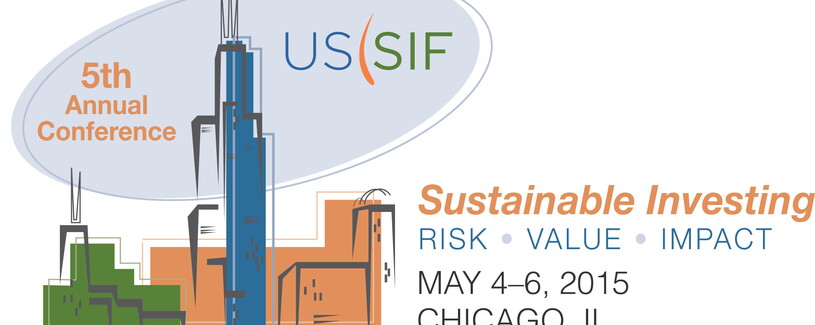Five Years Catalyzing Sustainable Investing at the 2015 US SIF Conference

A lot can happen in five years, especially when it comes to growth in sustainable investing. This year’s US SIF conference, held in Chicago from May 5-6, brought together over 380 professionals from investment firms, consultancies, foundations, academia, corporations and policy organizations to discuss current and future trends in sustainable, responsible and impact investing.
“We are delighted with the tremendous growth in attendance we have experienced over the past five years. It signals the growing interest in channeling assets under management into investments that advance important social and environmental issues,” said Lisa Woll, CEO of US SIF and the US SIF Foundation.
Since 2011, the year of the first US SIF conference, sustainable, responsible and impact investing has continued to gain traction. The latest US SIF report cites that, at the start of 2014, approximately $6.57 trillion US-domiciled assets were under management with some form of SRI strategy, up from approximately $3 trillion in 2010. This represents more than 100 percent growth in five years. The current figure now accounts for approximately one out of every six dollars under professional management in the United States.
Another sign that the sustainable investing “sphere of influence” is gaining traction globally is the AUM of the signatories to the United Nations Principles for Responsible Investing (PRI). With signatories representing assets over $35 trillion, this figure is estimated to represent approximately 51 percent of the total value of the global AUM. These figures are based on 2013 numbers.
To continue to grow however, the sustainable investing framework must apply across asset classes, integrate social and environmental issues and be geographically scalable.
Moreover, the sector must simultaneously engage two ends of a spectrum: existing multinational companies interested in sustainability issues alongside emerging, transformative companies that are just getting started but are fundamentally committed to having a positive social and environmental impact.
It’s a tall order.
But with all the environmental, social and governance (ESG) metrics, investment vehicles and thematic issues being discussed at venues like the US SIF conference, it is helpful to go back to an underlying framework to navigate through the noise. One of the closing plenary sessions helped provide this guidance in a discussion about so-called “Enlightened Finance,” or finance in the service of society, finance that is based on stewardship and serves as a means to a greater end.
In this plenary, a spokesperson for Enlightened Finance, John Taft, CEO of RBC Wealth Management – U.S., spoke to the audience about how the finance industry can harness the same creative energy that invented tools like credit default swaps and instead channel it toward the public good. He noted that, in the end, finance is “merely the architecture for society to realize its goals”—what society actually values shapes how the money ultimately flows.
In addition to a framework like Enlightened Finance, building community also matters. The conversations this year at the US SIF conference provided concrete examples that help illustrate the transformative work that is necessary to truly build a restorative economy and live up to the principles of “Enlightened Finance.” Sessions over two days spanned from water investments to the role of ESG consultants to creating standards to evaluate ESG-focused managers.
The investment community plays an integral role in the transition to a restorative economy. “From shareholder engagement, to screening/divestment, to proactive ESG/Impact investment strategies—sharing insights and approaches is instrumental in continuing the momentum in sustainable investing,” says Paul Hilton, US SIF Board Chair and Partner at Trillium Asset Management.
Ultimately, it is gatherings like the conference that US SIF provides for members and non-members that will continue to provide space for these conversations to mature in coming decades. With all the communication tools available at our fingertips, it is sometimes important to sit in a room with peers and remind ourselves of the larger framework in which we are operating.
To keep up on one aspect of sustainable investing, stay tuned for the Yale Center for Business and the Environment’s Conservation Finance Forum, a website and newsletter that will curate the latest news in the field, slated to launch spring 2016.